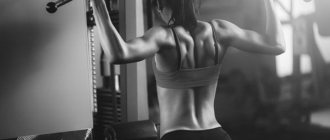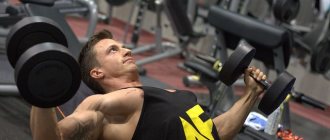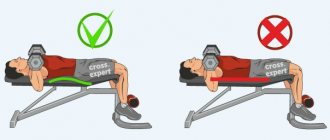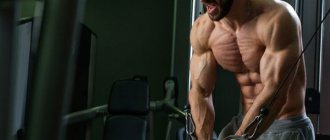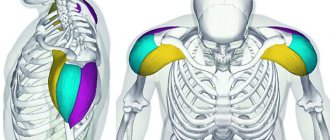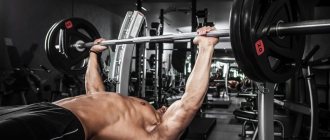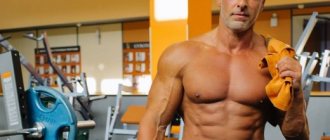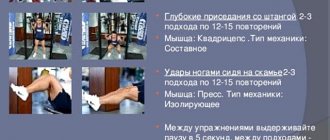Is it possible to pump up your chest without using a barbell or even dumbbells? After all, they are one of the most popular and affordable sports equipment for achieving results. However, this can be easily achieved using both regular push-ups and a horizontal bar.
Upper body muscle anatomy
When performing exercises on the horizontal bar, the muscles of the upper body are, of course, most often used:
- anterior large falciform muscle;
- Forearm muscle group;
- Deltoid group;
- Biceps arm muscle;
- Pectoralis major: Primarily the externus major and the hidden minor muscle.
- External oblique abdominal muscles;
- Pectoralis major muscle;
- trapezius muscle;
- arm muscles;
- latissimus dorsi muscle;
- rectus abdominis muscle (abdominal muscle);
- Cranial muscle of the arm;
- triceps;
- Sternocleidomastoid muscle;
Pull-up methods
Pull-ups are a basic exercise with basic technique. It is available to absolutely every man. Difficulties can arise only in people who are significantly overweight. There are several execution techniques.
The main nuance is the width of the grip or positioning of the hands; the distribution of the load on different muscle groups depends on this. Types of hand positioning (grips):
- medium (classic);
- wide;
- narrow;
- back;
- combined.
Classic pull-ups are performed with a medium grip, with your hands positioned directly under your shoulders. The grip is straight, that is, with your fingers away from you. This technique uses the latissimus dorsi and biceps.
Wide straight grip - hands positioned 1.5 shoulder width apart, fingers facing away from you. This method works the upper back, but the chest is practically not involved during execution.
Those who are interested in what grip to do pull-ups to pump up their pectoral muscles should master the technique of performing with a narrow position of the arms. The distance between the brushes is about 10-15 cm.
A reverse grip, when the hand is placed on the bar with your fingers facing you, primarily loads the biceps. Combined – this is for real fans of working on the horizontal bar. With this technique, one hand is positioned with a direct grip, the other with a reverse grip, but the distance between the hands can be any.
Is it possible to pump up your chest on the horizontal bar?
It's possible. But don’t rush to grab the bar and fly up. There is a serious caveat: it can only be performed in combination with other exercises.
Simply by doing pull-ups, you strengthen the muscles of your shoulders and back, which is very useful, but if your goal is beautiful breasts, you shouldn’t focus on just one bar.
If you've just decided to take control of your body and get ripped muscles, start with the following exercises:
- dumbbell extension;
- Push-ups (from a bench, from the floor, on parallel bars, from behind a bench);
- Bench press.
Isolation exercises
The inclusion of such exercises in a training complex is recommended for experienced athletes. For athletes with no more than 2 years of experience, doing a base on the chest will be enough.
Isolation exercises allow you to refine your muscle shape, that is, make it more prominent and expressive. They are performed at the end of strength training after a base with maximum weight. Consider the following few exercises with dumbbells to pump up your chest.
Dumbbell flyes
This exercise with dumbbells is the leader among isolated exercises. When performing it, one shoulder joint works, that is, the main effort is concentrated on the pectoral muscles.
Starting position:
- On the bench, take a sitting position with your knees bent.
- Place dumbbells on your knees in a vertical position.
- Take a lying position.
- Raise your arms with your elbows slightly bent so that the dumbbells are above your shoulders.
Technique:
- On a deep inhalation, arms are spread to the sides to the peak points. Then they are fixed in this position. At the same time, a pleasant feeling of stretching should appear in the chest muscles, but not without pain.
- As you exhale smoothly, your arms are slowly brought together without jerking until the dumbbells touch. Pause.
It is recommended to ensure that during the exercise you do not allow your arms to fully straighten to avoid injury to the elbow joint. It is also necessary to keep your back straight, since when you bend, part of the load is transferred from the chest to the lower back. As for the weight of dumbbells, it should be moderate.
Pullovers
Since using heavy weights and stimulating muscle fiber is very difficult in this exercise, it cannot be called the best exercise for the chest. But it contributes to the process of chest expansion, so it must be included in the training program of young athletes.
Starting position:
- Take dumbbells and place them with their ends on the floor near the bench.
- Take a lying position - only the upper back is on the bench.
- Bend your lower back and grab the dumbbell with both hands (by the upper part). You can ask someone to hand you dumbbells.
- Raise the barbell above your chest with your arms almost fully extended.
Technique:
- The dumbbell is lowered behind your head as you inhale, while your elbows should remain slightly bent.
- Following a similar trajectory, when you exhale, the dumbbell rises to its starting position.
This exercise must be performed smoothly, without haste or sudden movements. At the upper limit, the arms should not be fully straightened to avoid injury to the elbow joint. At the lower limit, you should lower the dumbbells as low as possible, stretching the chest muscles.
Let's look at isolation exercises for the chest using machines.
Butterfly trainer: hand pinch
Despite the many varieties of this simulator, they are all based on the same operating principle. To practice on it, no special training is required, and the likelihood of injury is practically reduced to zero. Perhaps this explains the popularity of this simulator among beginners who are not yet ready to work with a barbell.
Starting position:
- On the machine bench, take a sitting position with your back straight and tightly pressed to it.
- Your feet should be comfortably spaced shoulder-width apart.
- Wrap your hands around the handles, rest your forearms on the pillows.
Technique:
- Take a deep breath, then with a powerful movement as you exhale, bring your hands together until they touch.
- As you inhale, smoothly return your hands to the starting position.
When raising your arms, it is recommended to try not to reduce the load on the pectoral muscles
It is also important to keep your back pressed against the bench (do not lift it)
Crossover: hand pinch
Thanks to this exercise, the inner and lower parts of the chest muscles are worked out.
Starting position:
- Take a standing position between the exercise racks.
- Grab the handles.
- Bend slightly forward.
- Bend your arms slightly at the elbows.
Technique:
- With both hands, simultaneously pull the handles somewhere to the waist, exhaling at the extreme point.
- As you inhale, smoothly return your hands to the starting position.
Only the arms should work, the legs and the back should be kept motionless.
Pump up your pectoral muscles? Easily! Andrey Shmidt
Watch this video on YouTube
Correctly performing the above-described exercises for the chest muscles will allow you to achieve tangible results and become the owner of a beautiful, inflated chest!
Chest training program on the horizontal bar
We will work every day or three days in one, where one is rest. If we work on weekends, then every third day should be combined with intense training. As mentioned earlier, pull-ups are not the best way to strengthen your pectoral muscles, but they will help develop them overall. Therefore, maximal exercises are great for overall tone.
It is recommended to perform chest exercises on the pull-up bar in this order:
- Close grip pull-ups (10 times).
- Bench press (7-10 times).
- Pull-ups with a narrow reverse grip (10 times).
- Reverse grip pull-ups (10 times).
- Pull-ups behind the head with a wide grip (7-10 times).
Pull-ups are a great exercise not only for the chest, but for the entire body. However, this is a difficult task, and not every athlete will be able to complete it. Additionally, you may be physically fit but lack technique, making the exercise difficult to perform.
If you can do this exercise, finish each workout with as many reps as possible. This approach will not only strengthen your muscles, but will also force your body to work under stress, which will enhance the effect of weight gain. Moreover, it is emotional preparation. On the other hand, the overhead pull-ups in this set are performed more like a muscle stretch.
Additional recommendations
To make your training process as productive as possible, we will give you some valuable tips:
- Before starting your workout, you need to warm up properly. To do this, it is quite enough to jump rope for a few minutes and perform warm-up exercises for your joints. The main thing is that your body is hot and your pulse is 120-140 beats per minute.
- To pump your body more effectively, we recommend that you purchase a wall-mounted horizontal bar with parallel bars for your home. It often happens that in the summer a person is full of energy for street training, and with the onset of autumn and winter he gradually gives up on them. Not everyone will agree to go to training in cold weather.
- To avoid this, purchase a wall-mounted horizontal bar with parallel bars. Firstly, training at home will take up much less time. Secondly, you can study at any time of the day. Thirdly, the price of such sports equipment does not exceed 2 thousand rubles. If you decide to take your body seriously, then you should not skimp on this matter.
- Watch your diet. Eliminate all unnatural foods from your diet. Replace them with protein foods, fruits and vegetables.
- Drink at least two liters of water every day. It accelerates metabolic processes in the body and prevents fat deposition.
- Regularity is the main condition for success in this matter. If you are determined to train, do not skip training. Of course, there are good reasons such as illness. But if you're just lazy, force yourself to go to training. After it, you will be grateful to yourself for being able to overcome yourself.
- To prevent you from wanting to skip a workout, watch motivational videos. Believe me, when you see a person with a good figure, you will no longer want to skip workouts.
- Customize the training complex that we offered you above. Perhaps some exercises are not suitable for you. The main thing is that physical activity is regular.
Now you know how to transform your figure without visiting the gym. To do this, you need a horizontal bar, parallel bars and the desire to have a beautiful figure. Put these tips into practice, and within a few months you will become the proud owner of a powerful torso. I wish you success!
Originally posted 2018-01-29 10:09:09.
Pull-ups on the horizontal bar for the pectoral muscles
Once you have provided yourself with the necessary base, you can begin training on the pull-up bar. The first thing you need to know about pull-up technique is what grip to use.
Main types of grip:
- Reverse or underhand grip (palms facing inward);
- Regular or overhand grip (palms facing outward)
- In parallel, also neutral (palms facing each other).
Types are also classified according to working width:
- medium (arms at shoulder level);
- wide (arms wider than shoulder level)
- Narrow (arms wider than shoulders).
If the pull-up bar is a new experience for you and you can't pull yourself up, ask someone else to help you climb onto the bar and control your descent.
Regular/medium grip
- Place your hands shoulder-width apart, palms facing outward.
- As you exhale, bend your elbows and lift them so that your chin is above the bar.
- Relax your arms and inhale as you lower them.
- Try to do 3-5 pull-ups during your first workout. Our goal for the future is 3 sets of 15 pull-ups.
Remember that you need to lift your body smoothly, without jerking or swinging. The higher you go and the lower you go, the more noticeable this effect will be.
Reverse grip
The reverse grip is not the most effective technique for working the core, but it does have a significant impact on the biceps and latissimus dorsi.
To make this grip work for the pectoralis major and minor, try to focus and tighten your pecs as you pull up.
- Hands are slightly narrower than shoulder width, palms facing each other.
- Legs bent at the knees, you can cross your legs at the ankles.
- Rise up - exhale, fall down - inhale.
- Try to go up as high as possible and go down as low as possible.
Reverse-grip pull-ups are easier than regular-grip pull-ups, so try to do more on each attempt.
Parallel grip
The parallel grip pull-up is used as an assistance exercise to target the pecs, lats, lower back, biceps, and biceps.
- As you take the starting position, keep your arms as narrow as possible without experiencing discomfort.
- When performing pull-ups, touch the bar not with your chin, but with your chest.
- The downward movement should be shortened.
- The exercise is performed using the strength of the biceps.
Wide grip
The main difference between the wide grip technique is that it can be performed by touching the bar with the back of your head rather than your chin. This technique works primarily on the wide back grip muscles, but since our goal is to strengthen the pecs, we aim to touch the bar with our chest.
Wide grip pull-ups combined with the bench press give excellent results in building chest muscle mass. Perform the exercise with proper breathing, slowly, controlling the descent.
- Place your hands shoulder-width apart from each other.
- Inhale deeply, tensing the muscles of your back and chest.
- As you exhale, lift your chest toward the bar.
- Your elbows should remain more or less in the same place.
- Exhale and slowly lower yourself down.
Narrow grip
The goal is to pump up the chest, so let's focus on the close grip, which is the most challenging but provides the most intense impact on the shoulder and chest muscles. You can also increase the load on your pectoral muscles by leaning your torso forward and moving your legs as you pull up. This exercise is performed with both a regular and reverse grip.
- Grab the bar with your hands so that the distance between them is 10-20 cm.
- Tighten your chest and arm muscles.
- As you exhale, pull yourself up so that the bar touches the top of the pectoralis major muscle.
- Hold your body in this position for a second, and then slowly lower yourself down with an inhalation.
Dips
Power-ups, like pull-ups, are not ideal exercises for the pectoral muscles. If you train on outdoor equipment, we recommend doing push-ups. This element is best suited for working the lower chest. Let's look at the technique:
- We grab the edge of the bars, jump slightly and perform a handstand.
- We spread our elbows to the sides.
- We lower our chin to our collarbones, bend our knees so that our thighs are parallel to the ground and “round” our back.
- We fix this position and begin to smoothly do push-ups.
Peculiarities:
- It is advisable to perform the exercise on wide bars; on narrow bars, the triceps will be actively involved in the work;
- in the upper phase, do not straighten the elbow joints completely, otherwise the load on the chest will subside;
- We control all movements, avoid sharp jolts, swaying of the body and “throwing” the body down.
The exercise is performed for 3-4 sets of 10 repetitions each.
The last 2-3 push-ups in a set should be difficult. If this does not happen, it is necessary to increase the load with weights. For example, you can use soft weights on your legs or throw a backpack full of books over your shoulders.
Technical recommendations for performing pull-ups
- The optimal training plan is 3 times a week, 3 sets each (vary the number of pull-ups depending on your condition).
- The body must be strictly vertical in relation to the crossbar.
- Depending on the grip you use, either your chest touches the bar or your chin floats above it.
- The main thing to remember when training on the pull-up bar is proper breathing. Exhale and rise, inhale and lower. Exhale and pull up at the same time.
- For greater impact on the pectoral muscles, alternate between different types of grip.
- Make sure that your body does not sway from side to side during the exercise; pull-ups should be performed with muscle effort.
- Don't jerk, do everything slowly and smoothly.
- If you find it difficult to do pull-ups, use a bench. By the way, using a bench when lowering your body will help you avoid back injuries.
Doing pull-ups in combination with other exercises is a great way to build bigger and smaller breasts. A bonus to achieving your goal will be a strong back, beautiful biceps and strong arms. Thus, the main benefit of pull-ups is that by alternating different types of holds, you can tone your entire upper body and strengthen the muscles of the chest, back, abdomen and shoulders.
Treatment of the middle and upper chest
If you want to have harmoniously developed pectoral muscles, we recommend adding the elements presented below to the dips.
Middle section
- Wide push-ups (3x12). We lower ourselves into a classic prone position and spread our palms wide (about 1 meter). We stretch the torso and legs in one line and fix this position. We perform smooth push-ups.
- Dumbbell fly (3x12). We lie with our backs on a bench or place two chairs without backs next to each other and use them instead of a horizontal surface. Press your feet firmly to the floor. Take two dumbbells and lift them above your collarbones. We bend our elbows slightly and, with an inhalation, smoothly spread the projectiles. At the bottom point, we pause (1-2 seconds), and then exhale and bring our hands back to the starting position.
Upper section
- Push-ups with a raised pelvis (3x12). We stand upright while lying down. Raise your buttocks. The body resembles a triangle. Holding this position, we smoothly push up from the ground.
- Platform push-ups (3x12). We use any object 90–100 cm high as a platform. We take a lying position, resting the toes of our feet on the stand. We perform push-ups from this position.
You can train your chest with your own body weight and small weights 2 times a week, for example, on Monday and Thursday.
Don't forget about quality recovery: good sleep and protein nutrition.
By regularly performing the exercises presented in the article, you will give your pectoral muscles a beautifully defined shape.
Who is the horizontal bar contraindicated for?
If you have the initial stage of osteochondrosis, then the horizontal bar will definitely help you. But at stages 3 and 4, you should not exercise on the crossbar without a doctor’s recommendation. In general, I would recommend consulting with a specialist in any case.
Everything is very individual. For example, with protrusion, this is when the disc moves away from the spinal column, it all depends on the degree of pathology. But more often doctors recommend hanging or half-hanging on the bar.
You should not resort to this type of activity if you have the following diseases:
- diseases of the cardiovascular system;
- bronchial asthma;
- spinal injury and pathology of its blood vessels.
The main contraindication is exacerbation of osteochondrosis. Exercise only in a state of remission.
The second undesirable factor is obesity, since even with half-hanging on the horizontal bar, the spine will be subjected to enormous stress and too much stretching.
Hanging is contraindicated in cases of pathology of the cervical vessels and osteochondrosis of this area. They are also strictly prohibited in case of intervertebral hernia.
You cannot perform stretches on the horizontal bar if you have spondylosis and an increased degree of mobility of the spine.
The horizontal bar is contraindicated for obesity, since with excess weight the spine will be subjected to severe stress.
In any case, before classes you should consult a vertebrologist.
You can build a horizontal bar for hangs and pull-ups yourself, for example in a doorway. The advantage is that the height of the projectile can be adjusted as desired. As a last resort, a reliable branch is used to stretch for osteochondrosis.
In addition to the horizontal bar, regular swimming and gymnastics with a stick are great for stretching your back. The latter involves turning the body (holding the stick in front of you), raising the crossbar, bending and touching the floor with the stick.
Stretching on the horizontal bar is an effective exercise for osteochondrosis. By following the recommendations, you can achieve a stable result: relieving smooth muscle spasms, correctly distributing the load across parts of the spinal column, and improving general condition.
Can a beginner or overweight person do pull-ups?
I first encountered a horizontal bar at the age of 15.
It was 1994. My gym buddy and I went to his dad's garage for a back workout. He went to the horizontal bar and did 25 wide-grip pull-ups. I was impressed! It's my turn. I jumped up, spread my arms wide on the bar, gathered my strength and... pulled myself up once. Impressive, right? My 5 sets of 1 rep each went completely unnoticed that day. However, instead of avoiding the horizontal bar, I decided to master the basics of this difficult exercise for me on the horizontal bar for the back, and later began to hone my skills.
To do many pull-ups in one approach, you need to have good strength and endurance. But the number of repetitions performed is not the most important thing in this exercise.
The main thing is to set realistic goals and achievable goals, especially in the initial stages, because lifting your own body weight is not so easy.
Beginners should try jumping pull-ups to begin with, because the working muscles are included in the training process precisely during the negative phase of the back exercise on the horizontal bar, namely lowering rather than lifting the body up. It is important not just to go down sharply, but to perform the negative phase slowly and with maximum muscle tension, which will also reduce the risk of injury.
In my opinion, absolutely anyone with the right motivation and the necessary practice can catch up. Only practice and dedication will lead you to perfection!
If you can’t do it even once or just once, under no circumstances remove pull-ups from your training plan. Approaches with 1 repetition will eventually turn into 2 repetitions, and where 2 and three are not far away. You yourself will not notice how already 10 repetitions in one approach will seem like baby talk to you. My best result in one set was 37 wide-grip pull-ups. I can also do two pull-ups with an additional weight of 45 kg and 20 pull-ups with an additional weight of 11 kg. Inflating does not happen immediately. It took years of hard work to get such beautiful and powerful back muscles, but believe me, it's worth it.
Correct technique
A few tips will help you perform pull-ups correctly:
- do not arch your back;
- don't swing;
- initially you need to relax your shoulders;
- work evenly, do not linger at the bottom;
- do a warm-up;
- set clear goals for yourself.
Before starting classes, it is important to decide what you want to get in the end. For each goal, you need to choose your own training intensity, type of exercise, etc.
Warm up thoroughly, thereby you will warm up your muscles, prepare them for further work, and at the same time increase the effectiveness of pull-ups. Warm-up should be done in any case, regardless of the level of load. When hanging on the horizontal bar, relax your shoulders; they should not rise. Move smoothly; jerking reduces the effectiveness of the exercise.
Correct breathing
Exercises for the chest and other muscles on the horizontal bar and uneven bars become a dangerous activity if done incorrectly. A typical mistake for beginners is throwing their head back with a jerky movement, or excessively lifting their chin. The main movement of most practitioners is done while inhaling, and the shoulders are brought down to the chest. Such implementation often leads to severe injury to the cervical vertebrae; due to improper implementation, intervertebral hernias are possible.
Alexander Shestov
TRX Certified Trainer
Ask a Question
The technique for performing any exercise must be safe.
The correct technique implies mandatory filling of the chest with air when lifting, with a slight breath-hold at this moment; this technique will save you from straining small muscles. If performed correctly, there will be no severe pain in the upper body.
When pulling up, do not squirm your body. The main task of exercises on the bar is to work the back and chest, so repetitions performed at any cost are not needed here. If the amplitude is excessive, pull-ups must be performed with a counterweight. Strictly vertical ascents and descents are realized through the movement of the elbows.
Benefits of exercise
For maximum benefit, it is worth remembering the basic rules for performing exercises:
- Raising the torso should be carried out without inertia and swaying, solely by muscle strength.
- Work should be smooth, jerking is not allowed.
- The chin should be over the bar only at the top of the lift.
- It is necessary to lower the body down smoothly, and the ascent and descent must be equal in duration.
- Correct breathing involves exhaling on the way up and inhaling on the way down.
- You must grasp the crossbar confidently.
- The position of the body is strictly vertical.
Important! General rules apply to each type of pull-up, but working out individual exercises has its own nuances.
Characteristics of a Good Shoulder Workout
Intermediate delt training, like training for other body parts, is characterized by several important concepts:
- Emphasis on multi-joint exercises with a wide rep range of 6-12
- Multiple angles of work for maximum overall muscle growth.
- The priority of performing exercises with free weights over exercises performed on machines.
- Sufficient volume and intensity to enhance hormonal response.
This stage of training is all about building a foundation, and the best place to start your shoulder day is with some bench press variations. Some variations, such as dumbbell presses, are more difficult to master if you've never done them before. There are many technical points to consider, the article "The Overhead Press: A Beginner's Guide" covers many of them. Master this movement as it will become the foundation of shoulder training throughout your career.
As a beginner, you may not have done warm-up sets when training your shoulders, but they now become a more important part of your training the more advanced you become. Simply put, you will be lifting heavier weights and will need to do a few warm-up sets with lighter weights before doing so.
As you complete your build-up sets, warm-up sets, and build up your weight, begin your shoulder strength training by making it a little heavier at the beginning (failure at about 6 reps) than your typical hypertrophy-based workout (failure at 8 reps). -12)
As you complete your build-up sets, warm-up sets, and build up your weight, begin your shoulder strength training by making it a little heavier at the beginning (failure at about 6 reps) than your typical hypertrophy-based workout (failure at 8 reps). -12).
The best time to lift heavier weights is at the beginning of your workout, when muscle strength levels are highest and fatigue has not yet set in.
Many training programs follow the principle of a straight pyramid, where you use increasingly heavier weight with each new set. The programs below are based on the reverse pyramid principle, where you do more general working sets until muscle failure.
After a good warm-up and performing warm-up sets with light weights, move on to the heaviest 1-2 sets, reducing the weight on subsequent sets, taking into account the accumulated fatigue. Reduce the weight by about 5-10% as indicated in higher rep workouts.
After performing various types of presses, complete the workout with isolation exercises, where only one joint is worked, which will allow you to effectively work each of the three deltoid heads: frontal (front), lateral lateral or middle and dorsal (back).
Also here, a higher number of repetitions will help you finish the workout with a powerful muscle pump.
The final workout of the five shoulder programs, this pre-exhaustion workout, is the only one that doesn't follow the standard protocol of performing compound presses, which are done first.
For all of the intermediate shoulder workouts below, follow these tips:
The programs do not include warm-up approaches. Do as much as you need to warm up your shoulder muscles and joints and engage the mind-muscle connection, but never warm up to the point of fatigue. After warming up, select a weight that will allow you to reach muscle failure within the specified rep range. The repetition sequence for each exercise is a reverse pyramid, meaning that you lighten the weight slightly on subsequent sets and perform more reps on each after completing the first 1-2 heavy sets of compound exercises.
It is important to perform each set close to muscle failure. As an intermediate step, you need to expand your exercise repertoire that allows you to work your target muscle groups in different ways. Here our intention is to introduce you to some exercises that are new to you
Our intention here is to introduce you to some exercises that are new to you.
Don't be afraid to try something new. When learning a new exercise, use the technique described in this resource under the shoulder exercises section. Remember, poor exercise technique can lead to unnecessary stress on a joint or other muscle group.
Restrictions and contraindications
For people with spinal problems, it is better to start with horizontal pull-ups.
Pull-ups are not recommended for some spinal diseases:
- Osteochondrosis – exercise is allowed, but subject to certain rules. You cannot jump off the horizontal bar and perform jerking exercises. It is best to use a support.
- In case of hernias, the exercise is abandoned if the practitioner is overweight.
- During pregnancy, you can hang on the horizontal bar; pulling yourself up is prohibited.
Pull-ups on the horizontal bar are a basic multi-joint exercise. It is easier for men due to their wider shoulder, but women should not forget about it. When performed regularly, it replaces many exercise machines for the back and arms.
Increase the strength of your back muscles!
Pull-ups have no equal in effectiveness and versatility among other exercises for the back muscles.
Pull-ups pump up your back like no other exercise, but a few sets won't build up an impressive wing. Below you will find a truly effective workout plan for pumping up your back.
Each muscle group has its own standard exercise, performing which this group swings faster. Any training program includes such standard exercises for different muscle groups. When it comes to back training, pull-ups have no equal in terms of effectiveness and versatility.
Raising your body from a hanging position sounds simple, but is not practical for most people. Many basic exercises, such as squats or various forms of push-ups, for example, are found quite often in everyday life, which cannot be said about pull-ups. Even the most pumped-up weightlifters would rather lie under the barbell than climb onto the horizontal bar, because the latter is incredibly difficult to do. Don't be scared right away if you don't succeed the first time. In any case, you have to start somewhere.
To pump up your back and avoid back problems, which are common lately, start doing pull-ups on the horizontal bar right now for preventive purposes and to strengthen your back. This exercise can easily be included in any training plan.

